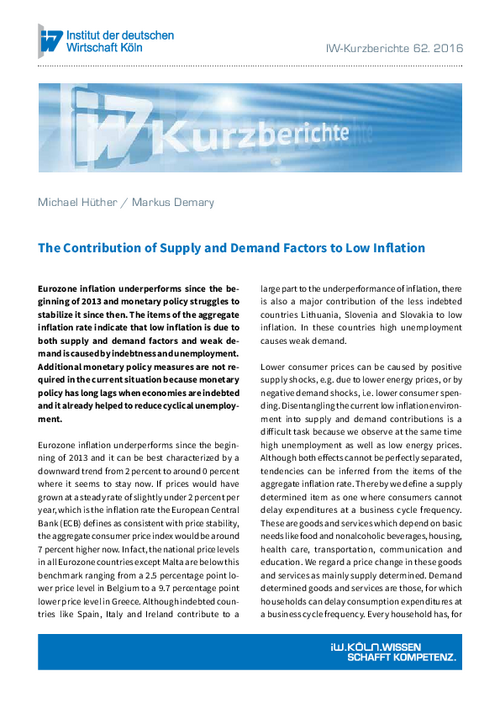Eurozone inflation underperforms since the beginning of 2013 and monetary policy struggles to stabilize it since then. The items of the aggregate inflation rate indicate that low inflation is due to both supply and demand factors and weak demand is caused by indebtness and unemployment. Additional monetary policy measures are not required in the current situation because monetary policy has long lags when economies are indebted and it already helped to reduce cyclical unemployment.

IW Monetary Outlook: The Contribution of Supply and Demand Factors to Low Inflation
IW-Kurzbericht

Eurozone inflation underperforms since the beginning of 2013 and monetary policy struggles to stabilize it since then. The items of the aggregate inflation rate indicate that low inflation is due to both supply and demand factors and weak demand is caused by indebtness and unemployment. Additional monetary policy measures are not required in the current situation because monetary policy has long lags when economies are indebted and it already helped to reduce cyclical unemployment.
Eurozone inflation underperforms since the beginning of 2013 and it can be best characterized by a downward trend from 2 percent to around 0 percent where it seems to stay now. If prices would have grown at a steady rate of slightly under 2 percent per year, which is the inflation rate the European Central Bank (ECB) defines as consistent with price stability, the aggregate consumer price index would be around 7 percent higher now. In fact, the national price levels in all Eurozone countries except Malta are below this benchmark ranging from a 2.5 percentage point lower price level in Belgium to a 9.7 percentage point lower price level in Greece. Although indebted countries like Spain, Italy and Ireland contribute to a large part to the underperformance of inflation, there is also a major contribution of the less indebted countries Lithuania, Slovenia and Slovakia to low inflation. In these countries high unemployment causes weak demand.
Lower consumer prices can be caused by positive supply shocks, e.g. due to lower energy prices, or by negative demand shocks, i.e. lower consumer spending. Disentangling the current low inflation environment into supply and demand contributions is a difficult task because we observe at the same time high unemployment as well as low energy prices. Although both effects cannot be perfectly separated, tendencies can be inferred from the items of the aggregate inflation rate. Thereby we define a supply determined item as one where consumers cannot delay expenditures at a business cycle frequency. These are goods and services which depend on basic needs like food and nonalcoholic beverages, housing, health care, transportation, communication and education. We regard a price change in these goods and services as mainly supply determined. Demand determined goods and services are those, for which households can delay consumption expenditures at a business cycle frequency. Every household has, for example, a basic stock of clothing, so purchases of new clothing can be delayed in times of unemployment or debt reduction. The same is true for expenditures for furniture or household maintenance works or expenditures for recreation and culture.
From the data can be inferred that the second round effects of low energy prices have already contributed to the underperformance of the price development in supply determined goods and services, like housing costs and transportation costs. Compared to the price stability benchmark, housing costs are 21.3 percentage points lower in Greece and 30.3 percentage points lower in Cyprus. Large underperformances can also be found in Spain, Italy, but also in Estonia, Lithuania and Slovakia. The highest contribution from lower transportation costs to aggregate inflation can be found in Estonia, Lithuania, Slovenia and Slovakia, but also in Ireland and Spain. In addition to lower energy prices, lower food prices contributed to low inflation in all Eurozone countries, with the largest effects in Ireland and Slovakia.
The ECB’s accommodative monetary policy tries to ease financial conditions by large-scale asset purchases in order to enable firms and households to increase their expenditures for goods and services. But monetary policy has the strongest effect on the purchases of demand determined goods and services and only limited effects on the prices of supply determined goods and services. The immediate effect of monetary policy should be on the prices of small-er-scale expenditures, like clothing, recreation and culture, restaurants and hotels, and then on larger-scale expenditures like furniture and household maintenance. The inflation data shows that the ECB has problems in increasing the prices of these goods and services. There is a large underperformance in the price development for clothing as well as for furniture and household maintenance and less severe underperformances in the price development for recreation and culture. In Greece prices for clothing, furniture and household maintenance and recreation and culture declined which is due to the high unemployment there. In Ireland and Cyprus it is the high household indebtness which causes the weak demand, especially for household maintenance works. In Spain high unemployment and high household indebtness lead to weak demand, but inflation underperformance is less severe here. In an environment which is characterized by indebtness and high unemployment, increasing the demand for largerscale expenditures, like household maintenance, is extremely challenging.
The analysis so far revealed the challenges the ECB faces in fulfilling its mandate of ensuring price stability. A large part of the inflation underperformance is supply driven and beyond the sphere of influence of the ECB and the demand driven inflation underperformance is due to high household indebtness and high unemployment, which restricts consumption expenditures. In such an environment the discussion of direct transfers from the central bank to households, so-called helicopter money, is gaining momentum. But as the analysis shows, helicopter money might only be able to revive the demand for small-scale expenditures like clothing, leisure and culture and restaurants and hotels, it would probably not suffice to increase larger-scale expenditures, like the purchases of furniture or household maintenance works. Therefore, its effectiveness will be smaller than its proponents estimate.
The problem with helicopter money is, that it intends to boost consumption, which is the least volatile component of GDP over the business cycle. The Eurozone’s consumption share of GDP is more or less constant with a value of 54.6 percent in 2006 and 53.7 percent in 2015, while the investment share of GDP fell from 23.3 percent in 2006 to 19.6 percent in 2015. Investment shares in GDP fell by more than 10 percentage points in Estonia, Ireland, Greece, Spain, Latvia, and Slovenia. Also Cyprus, Lithuania, Portugal and Slovakia have lower investment shares now. Helicopter money has no potential to increase business investment. The business cycle component of investment is low because firms have to reduce their debt levels and bank lending is still restrictive. Monetary policy’s effectiveness in reviving bank lending through negative interest rates is less effective because equity capital is still the limiting factor to bank lending. In the absence of supply-side reforms to revive investment and bank lending, monetary policy’s only leverage on investment lies in reducing borrowing costs through asset purchases, which helps the companies to deleverage, i.e. monetary policy works with long lags. Thus, the underperformance of inflation does not hint at an ineffectiveness of monetary policy in general, but is just a result of its very long lags in an environment which is characterized by high indebtness.
Although quantitative easing has not stabilized inflation up to now, it has helped to reduce unemployment in many Eurozone countries. Since the beginning of the ECB’s asset purchases in March 2015, the unemployment rate in Cyprus fell by 4.2 percentage points, in Spain and Greece by 2.8 and 2.2 percentage points, in Ireland and Portugal by 1.5 and 1.9 percentage points and in Slovenia and Slovakia by 1.2 and 2.0 percentage points. A similar picture emerged in the US, where the Federal Reserve Bank started its assets purchases programs earlier. Although the US inflation rate is still 1.2 percentage points below the Fed’s inflation target of 2 percent, the US unemployment rate declined about 0.9 percentage points per year until the end of the third QE-program and 0.4 percentage points per year since then.
The ECB has done a lot to stimulate the economy, but it cannot become more accommodative. Under the assumption that the ECB’s QE works with similar lags as the Fed’s QE and that it can similar to the Fed’s QE reduce cyclical unemployment by approximately 0.4 percentage points per year after QE has ended, the current policy stance could reduce the Eurozone unemployment rate by additional 1.8 percentage points in the upcoming three years. More policy accommodation is therefore not needed and might even be harmful because of the risks for financial stability that are already indicated by the high volume of negative yielding bonds.

Michael Hüther / Markus Demary: The Contribution of Supply and Demand Factors to Low Inflation
IW-Kurzbericht

More on the topic

German Wage Policy between Inflation and Stagnation: Are Conflicts with the Aims of Monetary Policy Looming?
After the economic and financial crisis of 2008/9, the German labour market soon began to recover, creating scope for a comparatively expansive wage policy.
IW
A Macroeconomic Analysis of Wage-Price Spirals
The subject of this Analysis is the forms that wage-price spirals can take and how they influence macroeconomic stability and inflationary trends in Germany.
IW